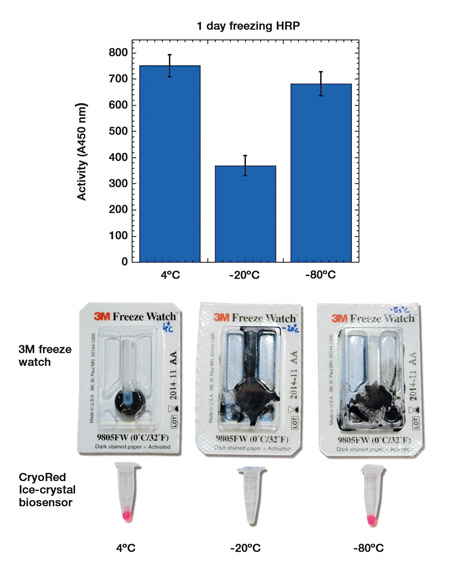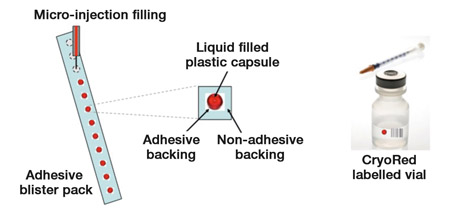Freeze-sensitive labels and electronic time-temperature indicators are increasingly finding use in monitoring vaccines as they pass through the cold chain supply network. Paul Goddard, CEO of Protein Technologies, reveals how fluorescent proteins could provide a more reliable visual indication of freeze damage in future.
The presence of a fluorescent component in the bioluminescent organs of Aequorea victoria jellyfish was noted by Davenport and Nicol in 1955,1 but it was not until 1962 that Osamu Shimomura of Princeton University first realised that this fluorophore was in fact a protein.2
The complete primary sequence of the 238 amino acids of Aequorea green fluorescent protein (GFP) was not finally revealed until the cloning and sequencing of its cDNA by Prasher in 1992.3 Thereafter the biochemical community was quick to embrace its use in a wide variety of labelling and imaging applications both in vitro and in vivo.
It is now common research practice for biologists to introduce a gene (or a gene chimera) encoding an engineered fluorescent protein into living cells and subsequently to visualise the location and dynamics of the gene product using fluorescence microscopy.
Specialist fluorescent protein development company Protein Technologies Ltd (PTL), of Manchester, UK, has engineered a series of fluorescent proteins that can act as reliable visual indicators of the formation of the large ice-crystals that are responsible for freeze damage. It has long been known that these crystals are produced when freezing takes place slowly because of the reduced number of nucleation sites around which the nascent crystals can form, although it has hitherto not been possible to visualise this process by a small, low-cost external indicator.
Because the formation of large ice-crystals leads to the denaturation of proteinaceous structures, fluorescent proteins make ideal ice-crystal biosensors as this event in turn brings about an irreversible change of colour and fluorescence. When the same fluorescent proteins are exposed to small ice-crystals, their colour and fluorescence remains unchanged, even if they are frozen at much lower temperatures.
PTL’s scientists Dr Farid Khan, an expert in fluorescent protein engineering, and Dr Tariq Ali, a molecular biologist, used GFP as a proof of concept. Having established the sensitivity of GFP to denaturation by large ice-crystals, the company then set about examining other fluorescent proteins, both to confirm the general nature of the phenomenon and to try to locate the most sensitive fluorophore. Its investigations led it first to wild type DSRed – a structural homologue of GFP – and then to DSRed2, a widely used mutant form of DSRed which has been engineered for enhanced solubility and faster chromophore maturation; due to its tetrameric structure, it is also orders of magnitude more stable than GFP.
Further structural modifications to these two proteins furnished derivatives that retained properties of thermal stability at high temperatures, but that were particularly sensitive to the formation of large ice-crystals at low temperatures. The addition of sensitizing agents to liquid formulations of the proteins rendered them still more sensitive to large ice-crystal formation, DsRed2 being especially susceptible to such at concentrations of 150mM (Figure 1).
To confirm that the structurally modified DsRed2 (CryoRed) was not only sensitive to the formation of large ice-crystals but that such sensitivity could also be correlated to the damage that would be caused to an actual product, PTL undertook experiments with an antibody-Horse Radish Peroxidase conjugate (aHRP).
Two samples of aHRP were respectively flash frozen to –80°C and slowly frozen to –20°C. After 24 hours the samples were then thawed and activity measured at 450nm. A 5% reduction in activity of the –80°C sample saw no discernible change in the colour of the CryoRed, while a 50% reduction in activity of the –20°C sample saw the CryoRed lose its colour altogether and turn completely clear.
The tests were further undertaken in parallel with 3M’s FreezeWatch – a leading freeze-sensitive label – that was unable to differentiate between retention and loss of activity in the two samples (see Figure 2).

Figure 2: Side by side comparison between CryoRed and a conventional freeze temperature indicator. It is not the freezing event per se that has an adverse effect on protein activity but rather the rate of freezing and the type of ice-crystals that are formed as a result. Here, CryoRed is able to differentiate between an antibody-conjugate that has been frozen to –20°C and suffered freeze damage and the same product that has been frozen to –80°C and has not
Potential benefits
The ability to differentiate between different types of freezing events in this manner has not been possible hitherto and has left manufacturers and cold chain supply companies with no choice but to err on the side of caution when adverse events take place. In 2006, for example, when a shipment of almost 20,000 flu vaccines was mistakenly frozen, Novartis elected to destroy the entire batch of 500,000 doses rather than risk the chances of a single patient suffering an immunogenic response.4
Fluorescent proteins exhibit a number of further advantages over conventional freeze detection solutions. As liquid suspensions, they lend themselves to formulation in blister packs or small stick-on labels; traditional freeze-sensitive labels and electronic time temperature indicators (eTTIs) are far too bulky to be attached to individual products.
A second major advantage is cost. The colloid-filled membranes on which freeze-sensitive labels are based call for complex fabrication and each eTTI requires a separate electronic circuit board. Because fluorescent proteins can be produced by fermentation, they can be manufactured as bulk liquids at relatively low cost.
With such versatility of formulation and low cost of manufacture, the potential applications for CryoRed are manifold. Because of its unmistakably bright fluorescence, CryoRed will allow individual vaccine vials to be labelled with a small, freeze-sensitive dot, just as they have been with heat-sensitive dots for many years (see Figure 3).
CryoRed can similarly be used with other biopharmaceutical products such as antibodies and protein or cell-based therapeutics. As these compounds become ever more structurally complex, the requirements for patient safety ever more stringent and the economic imperatives to operate efficient cold chain supply networks ever more pressing, the drive towards individual product labelling is likely to gain strength.

Figure 3: Blisterpack labelling of vaccines and cell-based products
Another application for CryoRed is in the quarantining of donor organs and tissues. Many of the adverse incidents that occur in the cold chain supply network come about as a result of failure of freezer-chillers. Typically, freezer-chillers maintain organs between 0°C and 4°C; however, when they break down, it is common for these units slowly to drop in temperature to –17°C to –25°C – ideal conditions for the formation of deleterious ice-crystals.
Such breakdowns are generally picked up by electronic alarms leading to the removal of the organs to a second, properly functioning freezer-chiller where they are then held in quarantine. As there are currently no means of assessing ice-crystal damage, however, subsequent visual inspection of the organs provides little information as to their true integrity, leading clinicians regrettably to discard them with potentially life-threatening consequences.
Stem cell preservation
A third major application for CryoRed relates once again to the current absence of any visual means of assessing ice-crystal formation. The cryopreservation of stem cells is a challenge as existing methods represent a trade-off between preventing the formation of damaging ice crystals and the toxic effects of cryoprotectants, notably DMSO. As a result, many stem cells must be administered in multiple dosages to minimise the risk of the side-effects of DMSO.
The use of CryoRed will allow clinicians to break free from this historical bind and utilise novel, low toxicity cryopreservatives, such as xylomannan, strong in the knowledge that any changes to the ice-crystal formation profile are quickly detectable. A million patients have already received stem cell therapy and the global market is forecast to triple in size in the next three years to more than US$60bn.
In June 2012, PTL and the University of Salford received a grant from the UK Technology Strategy Board to examine this application and hope to announce results in 2013.
Having recently filed a comprehensive patent on ice-crystal biosensors, PTL is currently seeking licensees for CryoRed in the packaging and reagents industries with a view to bringing the product to market within the next 8–12 months.
The company has also recently developed a second generation ice-crystal biosensor called CryoGreen which (in the manner of the traffic light warning system) is normally green but turns red on the formation of ice-crystals. It is also working on a second generation product called CryoThaw, which changes colour above 0°C, thereby providing a visual safety indicator for products that must be kept refrigerated or frozen.
References
1. D Davenport and JAC Nicol, Proc. R. Soc. London, Ser. B 144 (1955) 399–411
2. O Shimomura, et al. J. Cell. Comp. Physiol. 59 (1962) 223–29
3. DC Prasher, et al. Gene 111 (1992) 229–33
4. Temperature-sensing RFID chip could cut shipment losses. S Gotensparre, http://www.in-pharmatechnologist.com/Processing/Temperature-sensing-RFID-chip-could-cut-shipment-losses




